The battle for the best car paint protection solution often ignites heated discussions from both newbie car owners to seasoned drivers in Australia – ceramic coatings versus traditional waxes. Both methods boast their own advantages and disadvantages, leaving many to wonder: which reigns supreme in the realm of vehicular care?
Read on to learn more.
Ceramic Coating 101
Ceramic coatings are composed of silicon dioxide (SiO2) material that’s chemically bonded to the surface of your car’s paint, which creates a semi-permanent shield. This barrier repels water, dust, dirt, and other contaminants, safeguarding your paint from harmful ultraviolet (UV) rays, oxidation, and even minor scratches.
The Various Benefits Of Ceramic Coating For Your Car
- Unlike waxes that wear off in weeks, ceramic coating Sydney and nearby areas offers a robust defense that lasts for years, often exceeding five years with proper maintenance.
- Thanks to its water-repellent properties, ceramic coating causes water to bead up and roll off your car, minimizing water spots and keeping your car looking cleaner for longer. This characteristic also makes cleaning easier and less time-consuming.
- Ceramic coatings enhance the depth and gloss of your auto’s paint, revealing a showroom-quality finish that turns heads wherever you go.
- Cars with ceramic coating provide a shield against minor scratches and swirl marks, preserving your car’s pristine appearance.
- Ceramic coatings act as a barrier against harmful UV rays, preventing fading and discoloration, keeping your paint vibrant for years to come.
The Different Disadvantages Of Ceramic Coating
- Ceramic coatings require a significant initial investment, often exceeding the cost of traditional waxes by a significant margin.
- The application process can be complex and time-consuming, often requiring the expertise of a professional detailer for optimal results.
- Removing a ceramic coating can be difficult and often requires professional intervention, adding another layer of cost.
Traditional Wax 101
Waxes have been a trusted staple in car care for generations, offering an affordable and readily available solution for paint protection. Available in various forms, from liquid to paste, waxes are easy to apply and offer a layer of protection that lasts for several weeks, depending on the specific type and environmental conditions.
The Benefits Of Traditional Wax Coating
- Compared to ceramic coatings, traditional waxes are significantly more affordable, making them a budget-conscious option for many car owners.
- Applying wax is relatively simple and can be done yourself, even with minimal car care experience. This allows you to maintain your car’s paint at your own convenience and pace.
- Waxes come in various formulations, catering to diverse paint types and desired finishes. Whether you seek a deep gloss or a protective barrier, you can find a wax specifically suited to your needs.
- Unlike ceramic coatings, waxes require more frequent reapplication, but this process is simple and can be done regularly to maintain optimal protection.
The Drawbacks Of Traditional Wax Coating For Your Vehicle
- Compared to ceramic coatings, the protective layer offered by waxes is significantly less durable. Frequent reapplication is necessary to maintain the desired level of protection.
- While some waxes offer water-repellent properties, their effectiveness is often less pronounced and diminishes over time.
- Traditional waxes offer minimal protection against UV rays and minor scratches, leaving your vehicle’s paint more vulnerable to such elements.
Ceramic Coating vs. Traditional Wax: Which One Will Work Best For You
Ultimately, the champion of your automobile’s paint protection depends on your individual needs and preferences. If enduring protection and a showroom-quality shine are paramount, and your budget permits, ceramic coating is the better choice. Yet, if affordability and a do-it-yourself (DIY) approach are your priorities, traditional wax should be your go-to.
The following are the additional considerations you need to keep in mind when selecting between ceramic coating and traditional wax:
- Think of your local climate. If harsh weather conditions are frequent, a ceramic coating’s superior protection might be a wiser investment.
- Do you drive your car frequently? If so, a ceramic coating’s durability might prove advantageous, especially in dusty or dirty environments.
- Are you comfortable with regular maintenance? Traditional waxes require more frequent reapplication, while ceramic coatings demand less upkeep.
- Do you prefer a professional detailing experience or a DIY approach? Choose the method that aligns with your comfort level and available time.
Vehicle Surface Coating Upkeep 101
Regardless of your chosen method – ceramic coating, traditional wax, or a hybrid approach – incorporating the following practices into your routine will ensure optimal performance and maximize the lifespan of your paint protection:
- Consistent washing with high-quality car wash products removes dirt, dust, and contaminants that can erode the protective layer and compromise its effectiveness. Consider utilizing a two-bucket wash method to prevent cross-contamination and promote a scratch-free finish.
- Avoid harsh towels or chamois, as these can scratch the paint. Opt for microfiber towels specifically designed for car care, gently drying your car with a patting motion to prevent water spots.
- For ceramic coatings, consider utilizing a dedicated ceramic coating booster spray regularly. This revitalizes the hydrophobic properties and enhances water repellency, maintaining that showroom-quality shine.
- When washing your car, refrain from using harsh chemicals like degreasers or abrasive cleaners, as these can damage the protective layer. Opt for pH-neutral car wash products specifically formulated to be gentle on your paint.
- Excessive exposure to direct sunlight can accelerate the degradation of both waxes and ceramic coatings.
- Traditional waxes will require more frequent reapplication, typically every 2-3 months, to maintain their effectiveness. Ceramic coatings, while boasting longer-lasting protection, can still benefit from occasional touch-ups with a dedicated ceramic coating spray to maintain their hydrophobic properties.
To Conclude
Regardless of your choice between ceramic coatings and traditional waxes, the key to achieving optimal results lies in knowledge. Thoroughly research and understand the capabilities and limitations of each coating option. If unsure, consult with a car coating expert to help you out.









